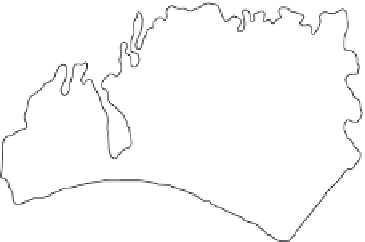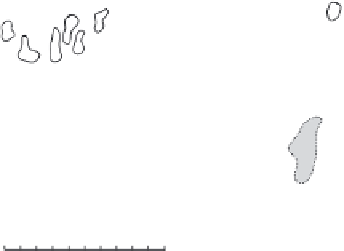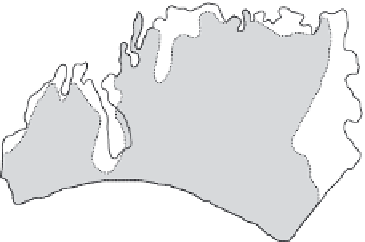Geoscience Reference
In-Depth Information
(a) Six Mens Bay
N
Reefs
0 (km) 10
Speightstown
Holetown
BARBADOS
0 m 100
Bridgetown
(b) Paynes Bay
Extent of reef development
1950
1991
Coastline
0 m 100
Fig. 9.21
Structural changes on fringing coral reefs on the west coast of Barbados between 1951 and 1991. At Six Mens Bay (a)
recession of most of the reef perimeter has occurred, although isolated outliers of live coral remain. This has resulted in a 24% reduction
in reef area. At Paynes Bay (b) major loss on the northern flank and in the central region has occurred, leading to a 21% reduction in reef
area. At both sites the areas of reef loss now comprise sand and rubble. (Adapted from Lewis 2002.)
history of recent disturbances, including eutro-
phication and storm damage (Lewis 2002). At
these sites, coral cover is reduced but, in addi-
tion, recent work has demonstrated large-scale
temporal change in the areal extent of reef
development. Three main types of structural
loss are identified:
1
degradation of spur-and 'groove' structures
on the seaward edge of reefs;
2
breaches in the reef front, leading to the
development of sand-filled valleys;
3
damage and loss of flank areas.
These sites provide clear evidence for reduced
reef development (Fig. 9.21) and changes in
carbonate production that can be attributed to
recent natural and anthropogenic disturbance
events. These types of change, where coral-
dominated reefs have shifted to algal-dominated
communities, are far from isolated examples,
and conform to the 'phase shift' concept of Done
(1992). Whether these changes are permanent
or whether they represent temporary shifts in
community state remains unclear.
9.5
MANAGEMENT AND REMEDIATION OF CORAL REEF
AND MANGROVE SEDIMENTS
Coral reef and mangrove environments are
susceptible to a range of disturbance events that
necessitate increasing attention from a manage-
ment and remediation perspective. In part, this
relates to the effects of anthropogenic-induced
disturbance and related ecological degradation,
which can in turn lead to destabilization of sedi-
ment substrates and increased rates of (shoreline)
erosion. Most coastal systems, however, are also
subject to shoreline change induced by natural
fluctuations in energy inputs (such as those
linked to storms, cyclones or tsunami). In these
cases, the need for effective management is often
driven not so much by the actual event, but as a























































